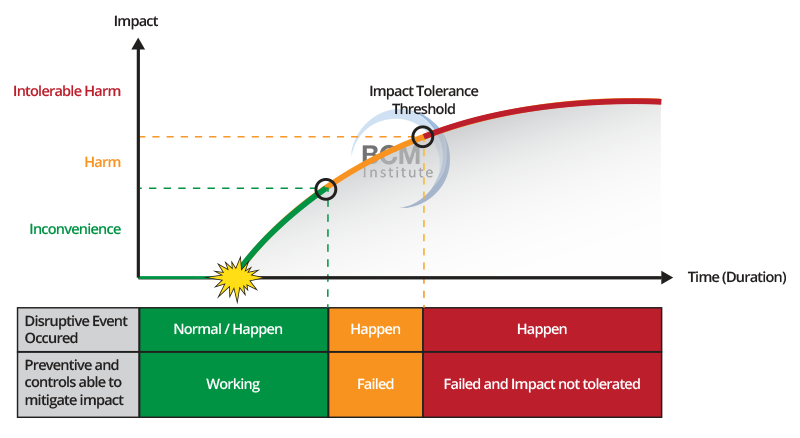Categorizing "Level of Harm" for Impact Tolerance

 Operational resilience is the ability of an organisation to adapt to and recover from disruptions to its critical business services.
Operational resilience is the ability of an organisation to adapt to and recover from disruptions to its critical business services.
 One important aspect of operational resilience is understanding the impact or level of harm to the customer when the organisation providing critical business services is disrupted.
One important aspect of operational resilience is understanding the impact or level of harm to the customer when the organisation providing critical business services is disrupted.
To categorise the level of harm, there are three levels:
- intolerable harm
- harm
- inconvenience.

Description of the Three "Levels of Harm"
| Intolerable Harm |
|
 Intolerable harm is "harm" that would severely impact the client, possibly leading to loss of life, severe financial loss, or damage to the customer's reputation or the organisation providing critical business services. Intolerable harm is "harm" that would severely impact the client, possibly leading to loss of life, severe financial loss, or damage to the customer's reputation or the organisation providing critical business services.
This level of harm requires immediate attention, and the organisation should have plans and procedures to mitigate the risk of intolerable harm.
For example, in the case of a bank, disruption to its critical business services that would result in customers losing access to their accounts or funds would be classified as intolerable harm.
|
| Harm |
|
 Harm refers to a level of harm that would cause significant disruption to the customer, potentially leading to financial loss, damage to the customer's reputation, or damage to the organisation providing critical business services. Harm refers to a level of harm that would cause significant disruption to the customer, potentially leading to financial loss, damage to the customer's reputation, or damage to the organisation providing critical business services.
This level of harm also requires attention, and the organisation should have plans and procedures to manage the risk of harm.
For example, in the case of an e-commerce website, disruption to its critical business services that would prevent customers from placing orders or accessing their order history would be classified as "harm."
|
| Inconvenience |
|
 Inconvenience refers to a "level of harm" that would cause a minor customer disruption, such as temporary inconvenience or delay. Inconvenience refers to a "level of harm" that would cause a minor customer disruption, such as temporary inconvenience or delay.
Still, it would not cause significant financial loss or damage to the customer's reputation or the organisation providing critical business services.
This level of harm is less critical, but the organisation should still have plans and procedures to manage the risk of inconvenience.
For example, in the case of a transportation company, a disruption to its critical business services that causes a delay in package arrival would be classified as an "inconvenience."
|
| |
Finally ...
In conclusion, understanding the levels of harm is crucial in operational resilience planning. Organisations should have plans and procedures to manage the risks associated with intolerable harm, harm, and inconvenience.
By doing so, the organisation can ensure the continuity of critical business services and maintain the trust of its clients.
Learn more about Blended Learning OR-300 [BL-OR-3] and OR-5000 [BL-OR-5]
To learn more about the course and schedule, click the buttons below for the OR-3 Blended Learning OR-300 Operational Resilience Implementer course and the OR-5 Blended Learning OR-5000 Operational Resilience Expert Implementer course.
 |
 |
 |
 |
 |
![[BL-OR] [3-4-5] View Schedule](https://no-cache.hubspot.com/cta/default/3893111/d0d733a1-16c0-4b68-a26d-adbfd4fc6069.png) |
![[BL-OR] [3] FAQ OR-300](https://no-cache.hubspot.com/cta/default/3893111/f20c71b4-f5e8-4aa5-8056-c374ca33a091.png) |
If you have any questions, click to contact us.![Email to Sales Team [BCM Institute]](https://no-cache.hubspot.com/cta/default/3893111/3c53daeb-2836-4843-b0e0-645baee2ab9e.png) |

|
 Operational resilience is the ability of an organisation to adapt to and recover from disruptions to its critical business services.
Operational resilience is the ability of an organisation to adapt to and recover from disruptions to its critical business services.  One important aspect of operational resilience is understanding the impact or level of harm to the customer when the organisation providing critical business services is disrupted.
One important aspect of operational resilience is understanding the impact or level of harm to the customer when the organisation providing critical business services is disrupted. 





![[BL-OR] [3-4-5] View Schedule](https://no-cache.hubspot.com/cta/default/3893111/d0d733a1-16c0-4b68-a26d-adbfd4fc6069.png)
![[BL-OR] [3] FAQ OR-300](https://no-cache.hubspot.com/cta/default/3893111/f20c71b4-f5e8-4aa5-8056-c374ca33a091.png)
![Email to Sales Team [BCM Institute]](https://no-cache.hubspot.com/cta/default/3893111/3c53daeb-2836-4843-b0e0-645baee2ab9e.png)








